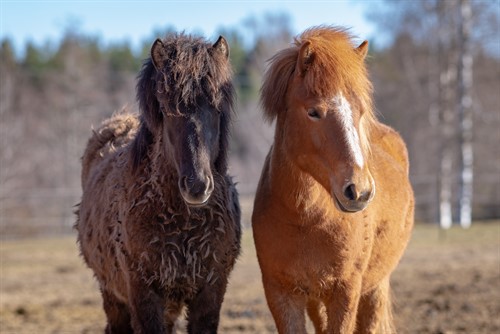
Equine Cushing’s Disease, also known as pituitary pars intermedia dysfunction (PPID) is one of the two most common endocrine disorders diagnosed in horses. The other is Equine Metabolic Syndrome (EMS). While PPID and EMS are completely separate conditions, nutritionists often make similar feeding recommendations for both situations. First, let’s define each condition.
Alphabet Soup – What is PPID and EMS?
PPID is a condition in which the pars intermedia – the center lobe of the pituitary gland located at the base of the brain – grows abnormally. This results in the overproduction of the hormone ACTH (adrenocorticotropin hormone). In turn, ACTH stimulates the release of cortisol from the adrenal glands, resulting in an abnormally high concentration of the hormone over time.
Chronically high concentrations of cortisol in the blood can lead to issues such as atypical fat deposits, long hair coat (even in the summer time), suppression of the immune system and insulin dysregulation. Cortisol is a steroid hormone, and long-term exposure to steroid hormones can predispose a horse to EMS.
When it comes to EMS, the primary concern is with insulin (a hormone) and glucose (sugar). The body keeps tight control of the amount of glucose in the blood. When glucose concentration rises, insulin provides a signal to store extra glucose in muscles and the liver. When a meal is consumed, insulin is secreted from the pancreas in response to sugars and starches in the food. With EMS, an abnormally high concentration of insulin is needed to control the amount of glucose circulating in the blood.
Chronically high concentrations of insulin, such as that seen with EMS, are known to cause laminitis. Additionally, a very high concentration of glucose in the blood over time can impair the small blood vessels in the body, which can cause problems with wound healing, vision, circulation and more. EMS can affect any horse of any age or breed, whether the horse is overweight or not.
A horse can have either PPID or EMS, and in some cases both. However, just because a horse has PPID does not mean he also has EMS, and vice versa. Horses diagnosed with PPID are certainly at risk for also developing EMS, but it doesn’t necessarily occur in every case. This is why testing by a veterinarian is so important. From a nutritionist’s point of view, the feeding recommendations will be very similar for both conditions.
Nutrition for the PPID (and EMS) Horse
When it comes to nutrition for the PPID or EMS horse, the goal is to control the amount of non-soluble carbohydrates in the diet. Non-soluble carbohydrates include starches and sugars, compared to soluble carbohydrates which are sources of fiber. (For this discussion, limiting carbohydrates refers to non-soluble carbohydrates.) But what constitutes a so-called low-carb diet? While science is still working on the exact answer, there are guidelines nutritionists use.
Here at BUCKEYE™ Nutrition and the WALTHAM® Equine Studies Group, we use the latest scientific research to develop nutrition plans for all horses, including those diagnosed with PPID and/or EMS. For general example, we suggest less than 20% NSC in the total diet, with even lower recommendations (10-12% NSC) for horses and ponies with a history of laminitis. Evaluation of the entire diet is essential, with particular attention paid to the source of forage and any supplemental concentrates fed on a daily basis.
For horses that have PPID and are underweight, we typically recommend adding a fat source for additional calories and weight gain. Fat will not exacerbate glucose and insulin. Exercise may need to be modified to help preserve some energy for improving body condition.
By contrast, the goal for overweight horses is to achieve weight loss without sacrificing essential vitamins, minerals and protein. Exercise is also a key factor in facilitating weight loss and maintaining muscle tone. A program can be designed for horses of all ability and soundness levels. For horses at maintenance, the focus would be on existing forage, ensuring limited carbohydrates and a controlled exercise program if the horse is sound enough to handle it.
At the end of the day, each horse is an individual and should be fed as such. Dietary recommendations should be based on a horse’s health status, activity level and forage source among other factors. At BUCKEYE Nutrition, you can reach out to our equine nutritionists, all of whom have advanced graduate degrees concentrating in equine nutrition, about the needs of your horse. We’re here to help make the world a better place for horses, so don’t hesitate to ask us!